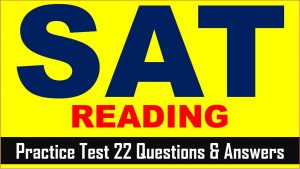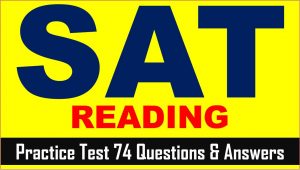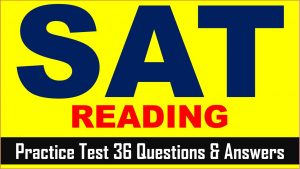SAT (Scholastic Assessment Test) is a standard test, used for taking admission to undergraduate programs of universities or colleges of the United States. SAT is developed and published by the College Board, an organization in the United States, administered by the Educational Testing Service. In this article of AKVTutorials, you will get SAT Practice Test 4 Answers | SAT 2024 Prep Online Classes AMBiPi.
SAT Reading Practice Passage
This passage is adapted from Virginia Woolf, Three Guineas. ©1938 by Harcourt, Inc. Here, Woolf considers the situation of women in English society.
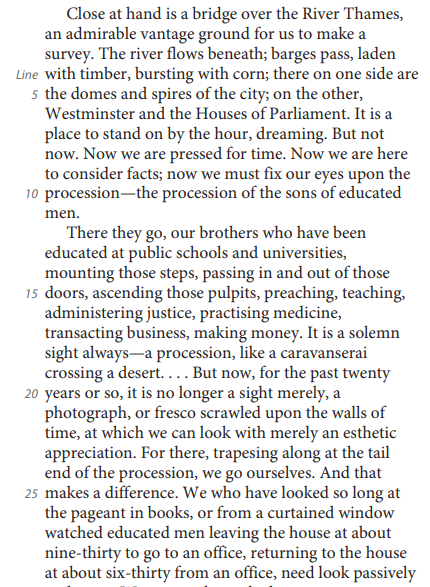
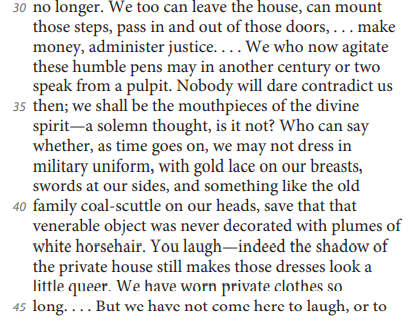
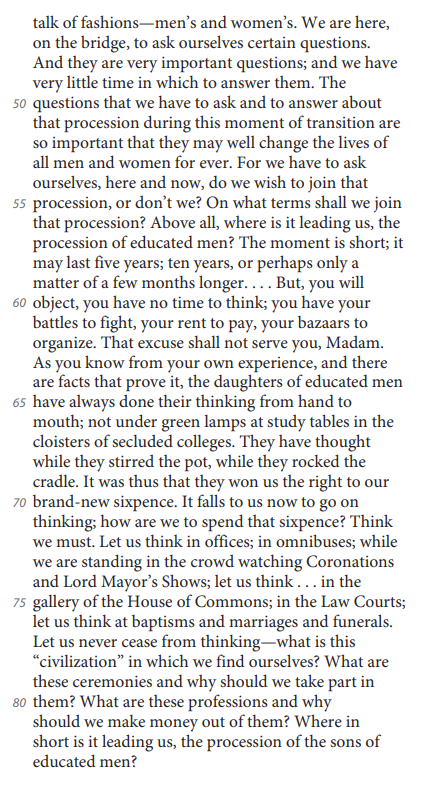
SAT Reading Comprehension Practice Test Questions
SAT Practice Test 4 Question No 1
The main purpose of the passage is to
Option A: emphasize the value of a tradition.
Option B: stress the urgency of an issue.
Option C: highlight the severity of social divisions.
Option D: question the feasibility of an undertaking.
SAT Practice Test 4 Answer No 1
Show/Hide Answer
Option B :
In this passage, Woolf asks women a series of questions. Woolf wants women to consider joining “the procession of educated men” (lines 56-57) by becoming members of the workforce. Woolf stresses that this issue is urgent, as women “have very little time in which to answer [these questions]” (lines 48-49).
Choice A is incorrect because Woolf argues against the tradition of only “the sons of educated men” (lines 82-83) joining the workforce. Choice C is incorrect because Woolf is not highlighting the severity of social divisions as much as she is explaining how those divisions might be reduced (with women joining the workforce). Choice D is incorrect because Woolf does not question the feasibility of changing the workforce dynamic.
SAT Practice Test 4 Question No 2
The central claim of the passage is that
Option A: educated women face a decision about how to engage with existing institutions.
Option B: women can have positions of influence in English society only if they give up some of their traditional roles.
Option C: the male monopoly on power in English society has had grave and continuing effects.
Option D: the entry of educated women into positions of power traditionally held by men will transform those positions.
SAT Practice Test 4 Answer No 2
Show/Hide Answer
Option A :
Throughout the passage, Woolf advocates for more women to engage with existing institutions by joining the workforce: “We too can leave the house, can mount those steps [to an office], pass in and out of those doors, . . . make money, administer justice . . .” (lines 30-32). Woolf tells educated women that they are at a “moment of transition” (line 51) where they must consider their future role in the workforce.
Choice B is incorrect because even though Woolf mentions women’s traditional roles (lines 68-69: “while they stirred the pot, while they rocked the cradle”), she does not suggest that women will have to give up these traditional roles to gain positions of influence. Choice C is incorrect because though Woolf wonders how “the procession of the sons of educated men” impacts women’s roles, she does not argue that this male-dominated society has had grave and continuing effects. Choice D is incorrect because while Woolf suggests educated women can hold positions currently held by men, she does not suggest that women’s entry into positions of power will change those positions.
SAT Practice Test 4 Question No 3
Woolf uses the word “we” throughout the passage mainly to
Option A: reflect the growing friendliness among a group of people.
Option B: advance the need for candor among a group of people.
Option C: establish a sense of solidarity among a group of people.
Option D: reinforce the need for respect among a group of people.
SAT Practice Test 4 Answer No 3
Show/Hide Answer
Option C :
Woolf uses the word “we” to refer to herself and educated women in English society, the “daughters of educated men” 11 (line 64). Woolf wants these women to consider participating in a changing workforce: “For there, trapesing along at the tail end of the procession[to and from work], we go ourselves” (lines 23-24). In using the word “we” throughout the passage, Woolf establishes a sense of solidarity among educated women.
Choice A is incorrect because Woolf does not use “we” to reflect on whether people in a group are friendly to one another; she is concerned with generating solidarity among women. Choice B is incorrect because though Woolf admits women have predominantly “done their thinking” within traditional female roles (lines 64-69), she does not use “we” to advocate for more candor among women. Choice D is incorrect because Woolf does not use “we” to emphasize a need for people in a group to respect one other; rather, she wants to establish a sense of solidarity among women.
SAT Practice Test 4 Question No 4
According to the passage, Woolf chooses the setting of the bridge because it
Option A: is conducive to a mood of fanciful reflection.
Option B: provides a good view of the procession of the sons of educated men.
Option C: is within sight of historic episodes to which she alludes.
Option D: is symbolic of the legacy of past and present sons of educated men.
SAT Practice Test 4 Answer No 4
Show/Hide Answer
Option B :
Woolf argues that the “bridge over the River Thames, [has] an admirable vantage ground for us to make a survey” (lines 1-3). The phrase “make a survey” means to carefully examine an event or activity. Woolf wants educated women to “fix [their] eyes upon the procession—the procession of the sons of educated men” (lines 9-11) walking to work.
Choice A is incorrect because while Woolf states the bridge “is a place to stand on by the hour dreaming,” she states that she is using the bridge “to consider the facts” (lines 6-9). Woolf is not using the bridge for fanciful reflection; she is analyzing “the procession of the sons of educated men” (lines 10-11). Choice C is incorrect because Woolf does not compare the bridge to historic episodes. Choice D is incorrect because Woolf does not suggest that the bridge is a symbol of a male-dominated past, but rather that it serves as a good place to watch men proceed to work.
SAT Practice Test 4 Question No 5
Woolf indicates that the procession she describes in the passage
Option A: has come to have more practical influence in recent years.
Option B: has become a celebrated feature of English public life.
Option C: includes all of the richest and most powerful men in England.
Option D: has become less exclusionary in its membership in recent years.
SAT Practice Test 4 Answer No 5
Show/Hide Answer
Option D :
Woolf writes that the men who conduct the affairs of the nation (lines 15-17: “ascending those pulpits, preaching, teaching, administering justice, practicing medicine, transacting business, making money”) are the same men who go to and from work in a “procession”(line 10). Woolf notes that women are joining this procession, an act that suggests the workforce has become less exclusionary: “For there, trapesing along at the tail end of the procession, we go ourselves” (lines 23-24).
Choice A is incorrect because the procession is described as “a solemn sight always” (lines 17-18), which indicates that it has always been influential. Choice B is incorrect because the passage does not indicate that this procession has become a celebrated feature of English life. Choice C is incorrect because the passage states only that the procession is made up of “the sons of educated men” (lines 10-11).
SAT Practice Test 4 Question No 6
Which choice provides the best evidence for the answer to the previous question?
Option A: Lines 12-17 (“There… money”)
Option B: Lines 17-19 (“It… desert”)
Option C: Lines 23-24 (“For… ourselves”)
Option D: Lines 30-34 (“We… pulpit”)
SAT Practice Test 4 Answer No 6
Show/Hide Answer
Option C :
As lines, 23-24 suggest that the workforce has become less exclusionary. In these lines, Woolf describes how women are joining the male-dominated procession that travels to and from the workplace: “For there, trapesing along at the tail end of the procession, we go ourselves.”
Choices A, B, and D are incorrect because they do not provide the best evidence for the answer to the previous question. Choice A is incorrect because lines 12-17 describe the positions predominantly held by men. Choice B is incorrect because lines 17-19 use a metaphor to describe how the procession physically looks. Choice D is incorrect because lines 30-34 hypothesize about future jobs for women.
SAT Practice Test 4 Question No 7
Woolf characterizes the questions in lines 53-57 (“For we… men”) as both
Option A: controversial and threatening.
Option B: weighty and unanswerable.
Option C: momentous and pressing.
Option D: provocative and mysterious.
SAT Practice Test 4 Answer No 7
Show/Hide Answer
Option C :
Woolf characterizes the questions she asks in lines 53-57 as significant (“so important that they may well change the lives of all men and women forever,” lines 52-53) and urgent (“we have very little time in which to answer them,” lines 48-49). Therefore, Woolf considers the questions posed in lines 53-57 as both momentous (significant) and pressing (urgent).
Choice A is incorrect because Woolf characterizes the questions as urgent and important, not as something that would cause controversy or fear. Choice B is incorrect because though Woolf considers the questions to be weighty (or “important”), she implies that they can be answered. Choice D is incorrect because Woolf does not imply that the questions are mysterious.
SAT Practice Test 4 Question No 8
Which choice provides the best evidence for the answer to the previous question?
Option A: Lines 46-47 (“We… questions”)
Option B: Lines 48-49 (“And… them”)
Option C: Line 57 (“The moment… short”)
Option D: Line 62 (“That… Madam”)
SAT Practice Test 4 Answer No 8
Show/Hide Answer
Option B :
The answer to the previous question shows how Woolf characterizes the questions posed in lines 53-57 as momentous and pressing. In lines 48-49, Woolf describes these questions as “important,” or momentous, and states that women “have very little time in which to answer them,” which shows their urgency.
Choices A, C, and D do not provide the best evidence for the answer to the previous question. Choices A and D are incorrect because lines 46-47 and line 62 suggest that women need to think about these questions and not offer trivial objections to them. Choice C is incorrect because line 57 characterizes only the need for urgency and does not mention the significance of the questions.
SAT Practice Test 4 Question No 9
Which choice most closely captures the meaning of the figurative “sixpence” referred to in lines 70 and 71?
Option A: Tolerance
Option B: Knowledge
Option C: Opportunity
Option D: Perspective
SAT Practice Test 4 Answer No 9
Show/Hide Answer
Option C :
Woolf writes that women “have thought” while performing traditional roles such as cooking and caring for children 13 (lines 67-69). Woolf argues that this “thought” has shifted women’s roles in society and earned them a “brand-new sixpence” that they need to learn how to “spend” (lines 70-71). The “sixpence” mentioned in these lines is not a literal coin. Woolf is using the “sixpence” as a metaphor, as she is suggesting women take advantage of the opportunity to join the male-dominated workforce.
Choices A, B, and D are incorrect because in this context, “sixpence” does not refer to tolerance, knowledge, or perspective.
SAT Practice Test 4 Question No 10
The range of places and occasions listed in lines 72-76 (“Let us… funerals”) mainly serves to emphasize how
Option A: novel the challenge faced by women is.
Option B: pervasive the need for critical reflection is.
Option C: complex the political and social issues of the day are.
Option D: enjoyable the career possibilities for women are.
SAT Practice Test 4 Answer No 10
Show/Hide Answer
Option B :
In lines 72-76, Woolf repeats the phrase “let us think” to emphasize how important it is for women to critically reflect on their role in society. Woolf states this reflection can occur at any time: “Let us think in offices; in omnibuses; while we are standing in the crowd watching Coronations and Lord Mayor’s Shows; let us think . . . in the gallery of the House of Commons; in the Law Courts; let us think at baptisms and marriages and funerals.”
Choices A, C, and D are incorrect because in lines 72-76 Woolf is not emphasizing the novelty of the challenge faced by women, the complexity of social and political issues, or the enjoyable aspect of women’s career possibilities.

